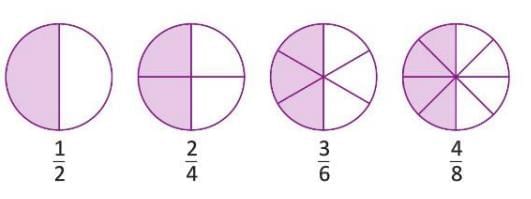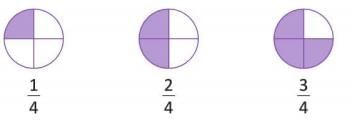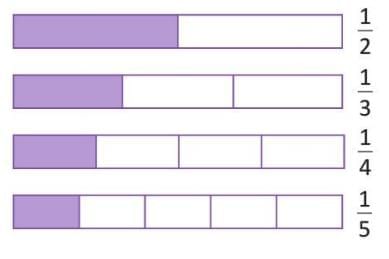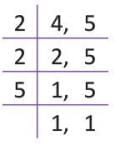Fractions Chapter Notes | Mathematics Class 5 ICSE PDF Download
Introduction
Imagine slicing a delicious pizza into equal pieces to share with your friends—each slice is a fraction of the whole pizza! Fractions are a fun and essential part of mathematics that help us understand how to divide things into smaller, equal parts. Whether it's sharing food, measuring ingredients, or solving real-world problems, fractions are everywhere. In this chapter, we'll explore what fractions are, their different types, and how to work with them through operations like addition, subtraction, multiplication, and division. Get ready to dive into the world of fractions and discover how they make math exciting and meaningful!
Fractions
A fraction shows a part of a whole or a collection divided into equal parts.
- It has two parts: numerator (top number, shows selected parts) and denominator (bottom number, shows total parts).
- Fraction = Numerator / Denominator.
- Example: In the fraction 9/11, 9 is the numerator (selected parts), and 11 is the denominator (total parts). This can be shown as 9 out of 11 equal parts of a whole.

Types of Fractions
- Like Fractions: Fractions with the same denominator.
Example: 1/8, 2/8, 3/8, 5/8, and 9/8 are like fractions because they all have the denominator 8. - Unlike Fractions: Fractions with different denominators.
Example: 2/5, 3/6, 5/9, 8/11, and 7/10 are unlike fractions because their denominators are different. - Unit Fractions: Fractions where the numerator is 1.
Example: 1/2, 1/4, 1/7, 1/9, and 1/8 are unit fractions because they all have a numerator of 1. - Equivalent Fractions: Fractions that represent the same value or part of a whole.
Example: 1/2, 2/4, 3/6, and 4/8 are equivalent fractions because they represent the same portion, and can be written as 1/2 = 2/4 = 3/6 = 4/8.
- Proper Fractions: Fractions where the numerator is less than the denominator (value less than 1).
Example: 11/18, 5/19, 6/11, 18/19, and 3/14 are proper fractions because the numerator is smaller than the denominator. - Improper Fractions: Fractions where the numerator is greater than or equal to the denominator (value greater than or equal to 1).
Example: 13/5, 3/2, 21/19, 17/10, and 11/11 are improper fractions because the numerator is greater than or equal to the denominator. - Mixed Fractions: A combination of a whole number and a proper fraction.
Example: 3 4/17, 2 7/15, 1 4/19, and 7 8/11 are mixed fractions because they include a whole number and a proper fraction.
Reciprocal of a Fraction
- The reciprocal of a fraction is found by swapping its numerator and denominator.
- Example: The reciprocal of 7/15 is 15/7, and the reciprocal of 1/3 is 3/1.
Finding Equivalent Fractions
Equivalent fractions can be found by multiplying or dividing both numerator and denominator by the same non-zero number.
By Multiplication:
- Multiply both numerator and denominator by the same number (not zero).
- Example: For 1/3, multiply by 2, 3, and 4: 1/3 = (1 × 2)/(3 × 2) = 2/6; 1/3 = (1 × 3)/(3 × 3) = 3/9; 1/3 = (1 × 4)/(3 × 4) = 4/12. So, 2/6, 3/9, and 4/12 are equivalent to 1/3.
By Division:
- Divide both numerator and denominator by the same number (not zero).
- Example: For 8/16, divide by 2, 4, and 8: 8/16 = (8 ÷ 2)/(16 ÷ 2) = 4/8; 8/16 = (8 ÷ 4)/(16 ÷ 4) = 2/4; 8/16 = (8 ÷ 8)/(16 ÷ 8) = 1/2. So, 4/8, 2/4, and 1/2 are equivalent to 8/16.
Checking Equivalent Fractions:
- Cross-multiply: Multiply the numerator of the first fraction by the denominator of the second, and vice versa. If products are equal, fractions are equivalent.
- Example: Check if 1/3 and 4/12 are equivalent: 1 × 12 = 4 × 3, 12 = 12. Since products are equal, 1/3 and 4/12 are equivalent fractions.
Reducing a Fraction to Its Lowest Terms
A fraction is in its lowest terms when the only common factor of the numerator and denominator is 1.
H.C.F. Method:
- Find factors of numerator and denominator.
- Identify the highest common factor (H.C.F.).
- Divide both numerator and denominator by the H.C.F.
- Example: Reduce 15/25: Factors of 15: 1, 3, 5, 15; Factors of 25: 1, 5, 25; Common factors: 1, 5; H.C.F. = 5. Divide: 15 ÷ 5 / 25 ÷ 5 = 3/5. So, 15/25 in lowest terms is 3/5.
Prime Factorization Method:
- Find prime factors of numerator and denominator.
- Identify common prime factors.
- Divide numerator and denominator by the product of common prime factors.
- Example: Reduce 15/25: Prime factors of 15: 3, 5; Prime factors of 25: 5, 5; Common factor: 5. Divide: 15 ÷ 5 / 25 ÷ 5 = 3/5. So, 15/25 in lowest terms is 3/5.
Converting Improper Fraction to Mixed Fraction
Divide the numerator by the denominator. Write the quotient as the whole number, the remainder as the numerator, and the divisor as the denominator.
- Formula: Mixed fraction = Quotient Remainder/Divisor.
Example: Convert 24/17 to a mixed fraction: 24 ÷ 17 = 1 (quotient), remainder 7. So, 24/17 = 1 7/17. - Alternative Method: Split the numerator so one part is divisible by the denominator, then simplify.
Example: 24/17 = (17 + 7)/17 = 17/17 + 7/17 = 1 + 7/17 = 1 7/17.
Converting Mixed Fraction to Improper Fraction
Multiply the whole number by the denominator. Add the result to the numerator. Write the sum as the new numerator, keeping the original denominator.
- Formula: (Whole number × Denominator) + Numerator / Denominator.
- Example: Convert 5 1/2: (5 × 2) + 1 = 10 + 1 = 11. So, 5 1/2 = 11/2.
Comparison of Fractions
Comparing Like Fractions
- Compare the numerators of fractions with the same denominator.
- The fraction with the larger numerator is greater.
- Example: Compare 5/11 and 9/11: Since 9 > 5, 9/11 > 5/11.

Comparing Unlike Fractions
Unlike Fractions with the Same Numerator:
- Compare denominators; the fraction with the smaller denominator is larger.
- Example: Compare 1/2, 1/3, 1/4, 1/5: Denominators: 2 < 3 < 4 < 5, so 1/2 > 1/3 > 1/4 > 1/5.

Unlike Fractions with Different Numerators:
- L.C.M. Method:
- Find the L.C.M. of the denominators.
- Convert fractions to equivalent fractions with the L.C.M. as the denominator.
- Compare the numerators.
- Example: Compare 3/4 and 2/5:
 L.C.M. of 4 and 5 = 20.
L.C.M. of 4 and 5 = 20. - 3/4 = 15/20,
- 2/5 = 8/20.
- Since 15 > 8,
- 3/4 > 2/5.
Cross-multiplication Method:
- Multiply the numerator of the first fraction by the denominator of the second, and vice versa.
- Compare the products; the fraction with the larger product is greater.
- Example: Compare 8/15 and 3/25:

- 8 × 25 = 200, 15 × 3 = 45.
- Since 200 > 45, 8/15 > 3/25.
Comparing Mixed Fractions
- Compare whole numbers; the fraction with the larger whole number is greater.
- If whole numbers are the same, compare the fractional parts.
- To compare a mixed fraction with a fraction, convert the mixed fraction to an improper fraction, then compare.
- Example: Compare 4 1/2 and 15/2: Convert 4 1/2 = (4 × 2 + 1)/2 = 9/2. Since 9 < 15, 9/2 < 15/2, so 4 1/2 < 15/2.
Ordering of Fractions
- Arrange fractions in ascending (smallest to largest) or descending (largest to smallest) order using comparison methods.
- For like fractions, compare numerators.
- For unlike fractions, use L.C.M. to convert to like fractions, then compare numerators.
- Example: Arrange 2/4, 1/4, 3/4 in ascending order:
- Compare numerators: 1 < 2 < 3, so 1/4 < 2/4 < 3/4.
Addition and Subtraction of Like and Unlike Fractions
Like Fractions:
- Add or subtract the numerators and keep the denominator the same.
- Reduce to lowest terms if needed.
- Example: Add 2/9 + 5/9 = (2 + 5)/9 = 7/9.
Unlike Fractions:
- Find the L.C.M. of the denominators.
- Convert fractions to equivalent fractions with the L.C.M. as the denominator.
- Add or subtract the numerators, keep the denominator, and reduce if needed.
- Example: Add 2/3 + 5/6: L.C.M. of 3 and 6 = 6. 2/3 = 4/6, 5/6 = 5/6. 4/6 + 5/6 = 9/6 = 1 3/6.
Addition and Subtraction of Whole Numbers and Fractions
- Convert the whole number to a fraction with a denominator 1.
- Find the L.C.M. of the denominators.
- Convert fractions to equivalent fractions with the L.C.M. as the denominator.
- Add or subtract the numerators, keep the denominator, and convert to a mixed fraction if needed.
- Example: Add 6 + 7/9: 6 = 6/1. L.C.M. of 1 and 9 = 9. 6/1 = 54/9, 7/9 = 7/9. 54/9 + 7/9 = 61/9 = 6 7/9.
Addition and Subtraction of Mixed Fractions
Method 1: Convert to Improper Fractions
- Convert mixed fractions to improper fractions.
- Convert to like fractions using L.C.M., then add or subtract.
- Convert the result to a mixed fraction if needed.
- Example: Add 4 2/5 + 2 1/5: 4 2/5 = 22/5, 2 1/5 = 11/5. 22/5 + 11/5 = 33/5 = 6 3/5.
Method 2: Add/Subtract Separately
- Add or subtract whole numbers and fractional parts separately.
- For fractional parts, convert to like fractions if needed, then add or subtract.
- Combine the results and simplify.
- Example: Add 4 2/5 + 2 1/5: Whole numbers: 4 + 2 = 6. Fractions: 2/5 + 1/5 = 3/5. Combine: 6 + 3/5 = 6 3/5.
Multiplication of Fractions
Multiplication of a Fraction by a Whole Number
- Multiply the whole number by the numerator of the fraction.
- Keep the denominator the same.
- Reduce to lowest terms or convert to a mixed fraction if needed.
- Example: Multiply 7 × 4/5: (7 × 4)/5 = 28/5 = 5 3/5.
Fraction of a Whole Number
- Multiply the fraction by the whole number.
- Simplify the result to the lowest terms.
- Example: Find 2/3 of 6: 2/3 × 6 = (2 × 6)/3 = 12/3 = 4.
Multiplication of a Fraction by Another Fraction
- Multiply the numerators to get the new numerator.
- Multiply the denominators to get the new denominator.
- Reduce to lowest terms or convert to a mixed fraction if needed.
- Example: Multiply 2/7 × 3/5: (2 × 3)/(7 × 5) = 6/35.
Properties of Multiplication of Fractions
- The order of multiplying two fractions does not change the result.
Example: 3/7 × 4/5 = 4/5 × 3/7 = 12/35. - Three fractions can be grouped in any order for multiplication.
Example: (2/3 × 5/6) × 3/4 = 2/3 × (5/6 × 3/4). - The product of a fraction and 0 is 0.
Example: 1/10 × 0 = 0. - The product of a fraction and 1 is the fraction itself.
Example: 1/8 × 1 = 1/8.
Division of fractions
Division of a Whole Number by a Fraction
- Multiply the whole number by the reciprocal of the fraction.
- Simplify the result to the lowest terms.
- Example: Divide 16 ÷ 1/4: Reciprocal of 1/4 is 4/1. 16 × 4/1 = 64.
Division of a Fraction by a Whole Number
- Multiply the fraction by the reciprocal of the whole number.
- Simplify the result to the lowest terms.
- Example: Divide 3 4/7 ÷ 15: 3 4/7 = 25/7. Reciprocal of 15 is 1/15. 25/7 × 1/15 = 25/105 = 5/21.
Division of a Fraction by Another Fraction
- Multiply the first fraction by the reciprocal of the second fraction.
- Simplify the result to the lowest terms or convert to a mixed fraction.
- Example: Divide 3/8 ÷ 9/4: Reciprocal of 9/4 is 4/9. 3/8 × 4/9 = (3 × 4)/(8 × 9) = 12/72 = 1/6.
Properties of Division of Fractions
- The order of division matters; dividing fractions in different orders gives different results.
Example: 2/3 ÷ 4/5 = 5/6, but 4/5 ÷ 2/3 = 6/5, so 2/3 ÷ 4/5 ≠ 4/5 ÷ 2/3. - A fraction divided by itself equals 1.
Example: 6/7 ÷ 6/7 = 6/7 × 7/6 = 1. - A fraction divided by 1 equals the fraction itself.
Example: 15/23 ÷ 1 = 15/23 × 1/1 = 15/23. - Zero divided by a fraction is 0.
Example: 0 ÷ 8/11 = 0 × 11/8 = 0. - A fraction divided by 0 is not defined.
Example: 3/5 ÷ 0 is not defined.
Word Problems on Addition and Subtraction of Fractions
- Convert mixed fractions to improper fractions if needed.
- Find the L.C.M. of denominators for unlike fractions.
- Add or subtract the fractions and simplify the result.
Example: A bus covers 55 3/4 km in the first hour, 58 2/5 km in the second hour, and 78 1/2 km in the third hour. Find the total distance covered.
Sol:
- Convert mixed fractions to improper fractions: 55 3/4 = (55 × 4 + 3)/4 = 223/4; 58 2/5 = (58 × 5 + 2)/5 = 292/5; 78 1/2 = (78 × 2 + 1)/2 = 157/2.
- Find the L.C.M. of denominators 4, 5, and 2: Factors of 4: 1, 2, 4; Factors of 5: 1, 5; Factors of 2: 1, 2; L.C.M. = 2 × 2 × 5 = 20.
- Convert fractions to denominator 20: 223/4 = (223 × 5)/(4 × 5) = 1115/20; 292/5 = (292 × 4)/(5 × 4) = 1168/20; 157/2 = (157 × 10)/(2 × 10) = 1570/20.
- Add the numerators: 1115/20 + 1168/20 + 1570/20 = (1115 + 1168 + 1570)/20 = 3853/20.
- Convert to mixed fraction: 3853 ÷ 20 = 192 remainder 13, so 3853/20 = 192 13/20 km.
- So, the total distance covered is 192 13/20 km.
Word Problems on Multiplication and Division of Fractions
- For multiplication, multiply fractions directly and simplify.
- For division, multiply by the reciprocal and simplify.
- Example: At a gaming station, 1/2 of games are racing games, and 2/5 of those are car racing games. Then Fraction of car racing games: 2/5 × 1/2 = 1/5.
Solved Examples
Example 1: Find three equivalent fractions of 1/7.
Sol:
- Multiply the numerator and denominator of 1/7 by 2: (1 × 2)/(7 × 2) = 2/14.
- Multiply the numerator and denominator of 1/7 by 3: (1 × 3)/(7 × 3) = 3/21.
- Multiply the numerator and denominator of 1/7 by 4: (1 × 4)/(7 × 4) = 4/28.
- So, the equivalent fractions of 1/7 are 2/14, 3/21, and 4/28.
Example 2: Reduce 15/25 to its lowest terms using the H.C.F. method.
Sol:
- Find the factors of 15: 1, 3, 5, 15.
- Find the factors of 25: 1, 5, 25.
- Identify common factors: 1, 5.
- Find the H.C.F.: The highest common factor is 5.
- Divide numerator and denominator by 5: 15 ÷ 5 = 3, 25 ÷ 5 = 5.
- So, 15/25 in lowest terms is 3/5.
Sol:
- Divide the numerator (24) by the denominator (17): 24 ÷ 17 = 1 (quotient) with a remainder of 7 (24 - 17 = 7).
- Write the quotient as the whole number: 1.
- Write the remainder as the numerator: 7.
- Keep the denominator: 17.
- So, 24/17 = 1 7/17.
Example 4: Convert 5 4/7 to an improper fraction.
Sol:
- Multiply the whole number (5) by the denominator (7): 5 × 7 = 35.
- Add the numerator (4) to the result: 35 + 4 = 39.
- Write the sum as the new numerator with the original denominator: 39/7.
- So, 5 4/7 = 39/7.
Example 5: Compare 3/4 and 2/5 using the L.C.M. method.
Sol:
- Find the L.C.M. of the denominators 4 and 5: Factors of 4: 1, 2, 4; Factors of 5: 1, 5; L.C.M. = 2 × 2 × 5 = 20.
- Convert 3/4 to an equivalent fraction with denominator 20: 3/4 = (3 × 5)/(4 × 5) = 15/20.
- Convert 2/5 to an equivalent fraction with denominator 20: 2/5 = (2 × 4)/(5 × 4) = 8/20.
- Compare the numerators: 15 > 8, so 15/20 > 8/20.
- Therefore, 3/4 > 2/5.
Example 6: Arrange 5/9, 4/7, and 3/11 in ascending order.
Sol:
- Find the L.C.M. of the denominators 9, 7, and 11: Prime factors: 9 = 3 × 3, 7 = 7, 11 = 11; L.C.M. = 3 × 3 × 7 × 11 = 693.
- Convert 5/9 to an equivalent fraction: 693 ÷ 9 = 77, so 5/9 = (5 × 77)/(9 × 77) = 385/693.
- Convert 4/7 to an equivalent fraction: 693 ÷ 7 = 99, so 4/7 = (4 × 99)/(7 × 99) = 396/693.
- Convert 3/11 to an equivalent fraction: 693 ÷ 11 = 63, so 3/11 = (3 × 63)/(11 × 63) = 189/693.
- Compare the numerators: 189 < 385 < 396.
- Arrange in ascending order: 189/693 < 385/693 < 396/693, so 3/11 < 5/9 < 4/7.
Sol:
- Find the L.C.M. of the denominators 3 and 6: Factors of 3: 1, 3; Factors of 6: 1, 2, 3, 6; L.C.M. = 6.
- Convert 2/3 to an equivalent fraction with denominator 6: 2/3 = (2 × 2)/(3 × 2) = 4/6.
- Keep 5/6 as it is: 5/6 = 5/6.
- Add the numerators: 4/6 + 5/6 = (4 + 5)/6 = 9/6.
- Simplify 9/6: 9 ÷ 6 = 1 remainder 3, so 9/6 = 1 3/6.
- So, 2/3 + 5/6 = 1 3/6.
Example 8: Subtract 11/34 from 12/17.
Sol:
- Find the L.C.M. of the denominators 17 and 34: Factors of 17: 1, 17; Factors of 34: 1, 2, 17, 34; L.C.M. = 34.
- Convert 12/17 to an equivalent fraction with denominator 34: 12/17 = (12 × 2)/(17 × 2) = 24/34.
- Keep 11/34 as it is: 11/34 = 11/34.
- Subtract the numerators: 24/34 - 11/34 = (24 - 11)/34 = 13/34.
- So, 12/17 - 11/34 = 13/34.
Example 9: Multiply 3 1/4 by 18.
Sol:
- Convert 3 1/4 to an improper fraction: (3 × 4 + 1)/4 = (12 + 1)/4 = 13/4.
- Write 18 as a fraction: 18 = 18/1.
- Multiply: 13/4 × 18/1 = (13 × 18)/(4 × 1).
- Simplify by finding common factors: 18 = 2 × 9, 4 = 2 × 2, common factor = 2.
- Divide: (13 × 18 ÷ 2)/(4 ÷ 2) = (13 × 9)/2 = 117/2.
- Convert to mixed fraction: 117 ÷ 2 = 58 remainder 1, so 117/2 = 58 1/2.
- So, 3 1/4 × 18 = 58 1/2.
Example 10: Divide 3 2/9 by 14/27.
Sol:
- Convert 3 2/9 to an improper fraction: (3 × 9 + 2)/9 = (27 + 2)/9 = 29/9.
- Find the reciprocal of 14/27: Reciprocal = 27/14.
- Multiply: 29/9 × 27/14 = (29 × 27)/(9 × 14).
- Simplify: 27 = 3 × 9, 9 = 3 × 3, common factor = 9; (29 × 27 ÷ 9)/(9 ÷ 9 × 14) = (29 × 3)/(1 × 14) = 87/14.
- Convert to mixed fraction: 87 ÷ 14 = 6 remainder 3, so 87/14 = 6 3/14.
- So, 3 2/9 ÷ 14/27 = 6 3/14.
Sol:
- Total paint used for 2 rooms = 2/5.
- Paint used for 1 room = 2/5 ÷ 2 = 2/5 ÷ 2/1.
- Find the reciprocal of 2: Reciprocal = 1/2.
- Multiply: 2/5 × 1/2 = (2 × 1)/(5 × 2) = 2/10.
- Simplify: 2/10 = (2 ÷ 2)/(10 ÷ 2) = 1/5.
- So, the painter used 1/5 of the paint for each room.
|
123 docs|15 tests
|
FAQs on Fractions Chapter Notes - Mathematics Class 5 ICSE
| 1. What are the different types of fractions? |  |
| 2. How do you find equivalent fractions? |  |
| 3. What does it mean to reduce a fraction to its lowest terms? |  |
| 4. How can you convert an improper fraction to a mixed fraction? |  |
| 5. How do you compare and order fractions? |  |





















